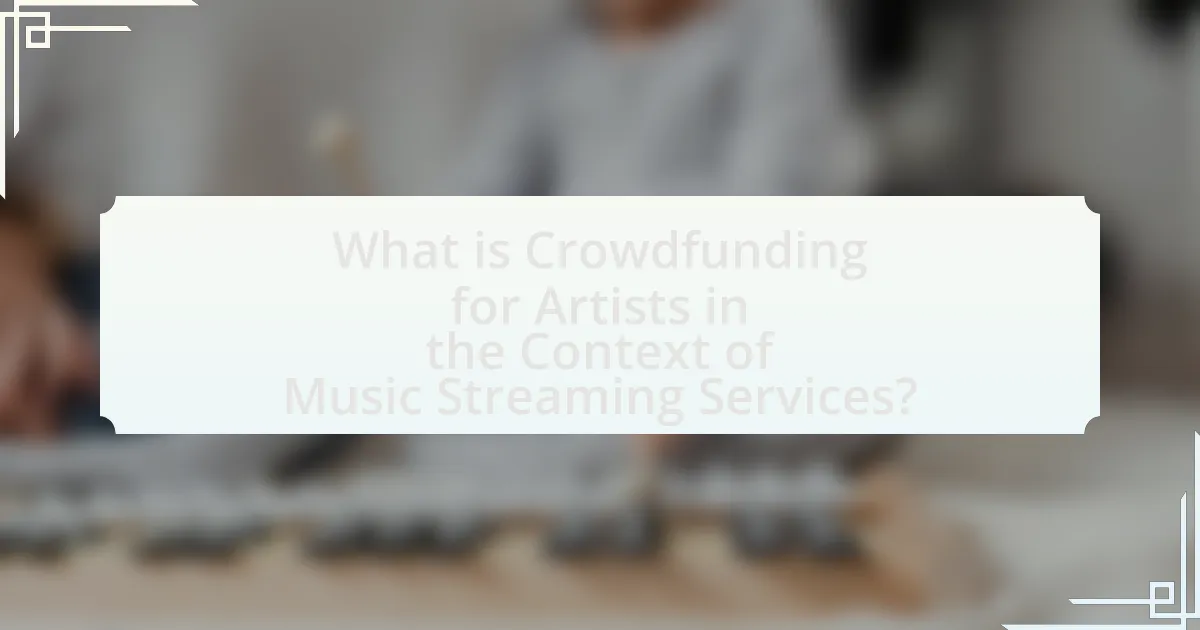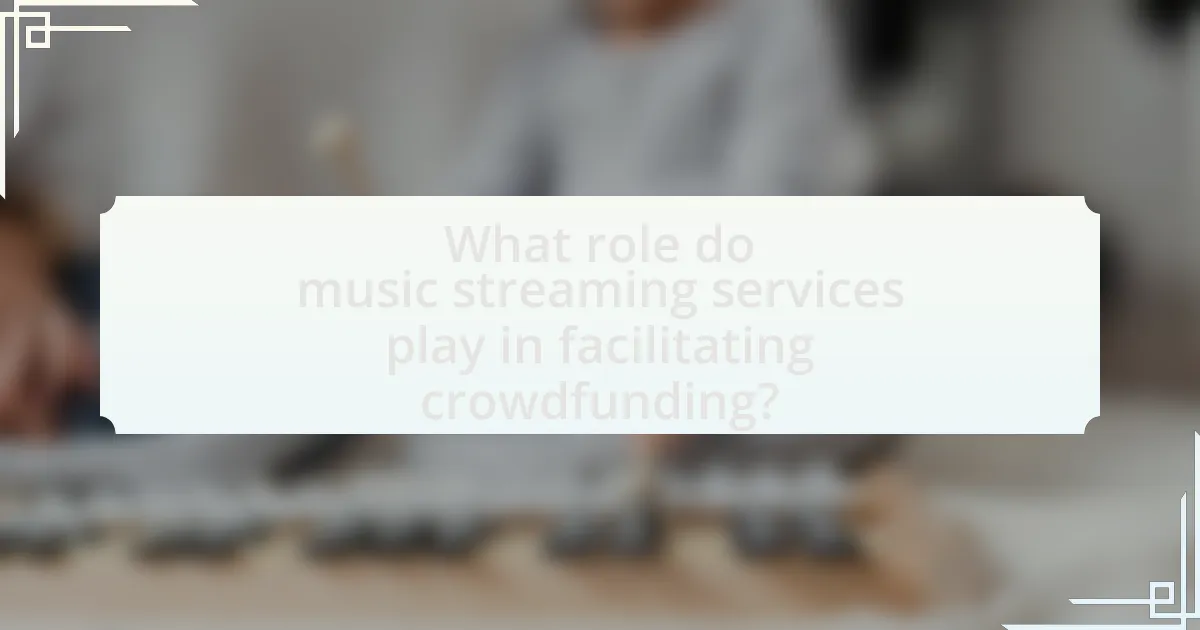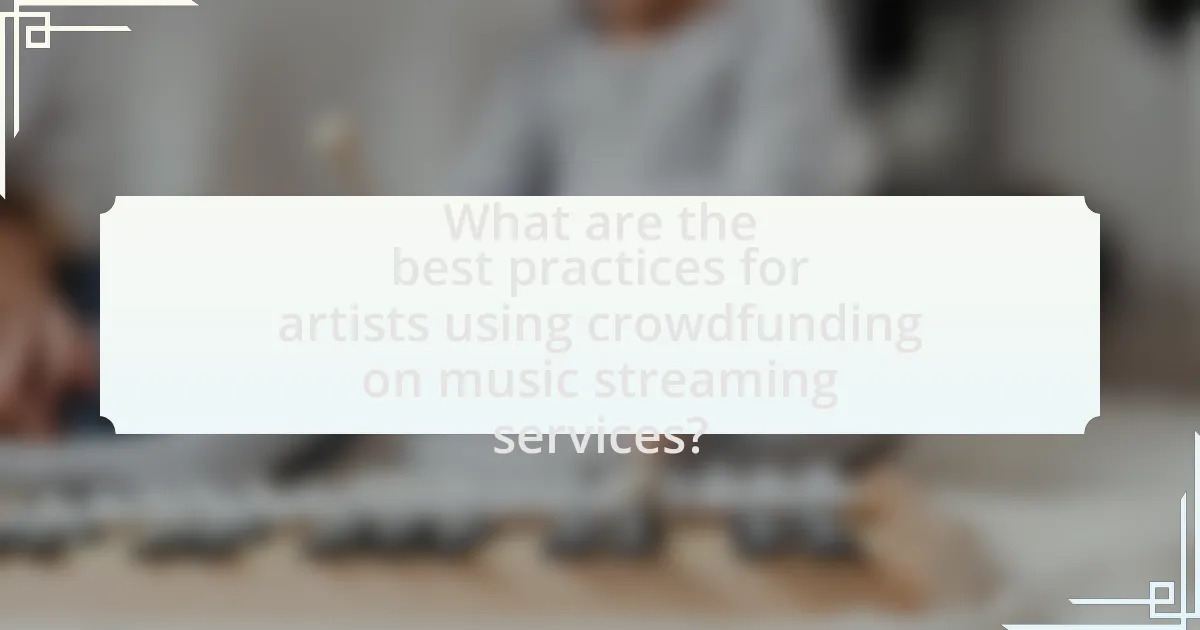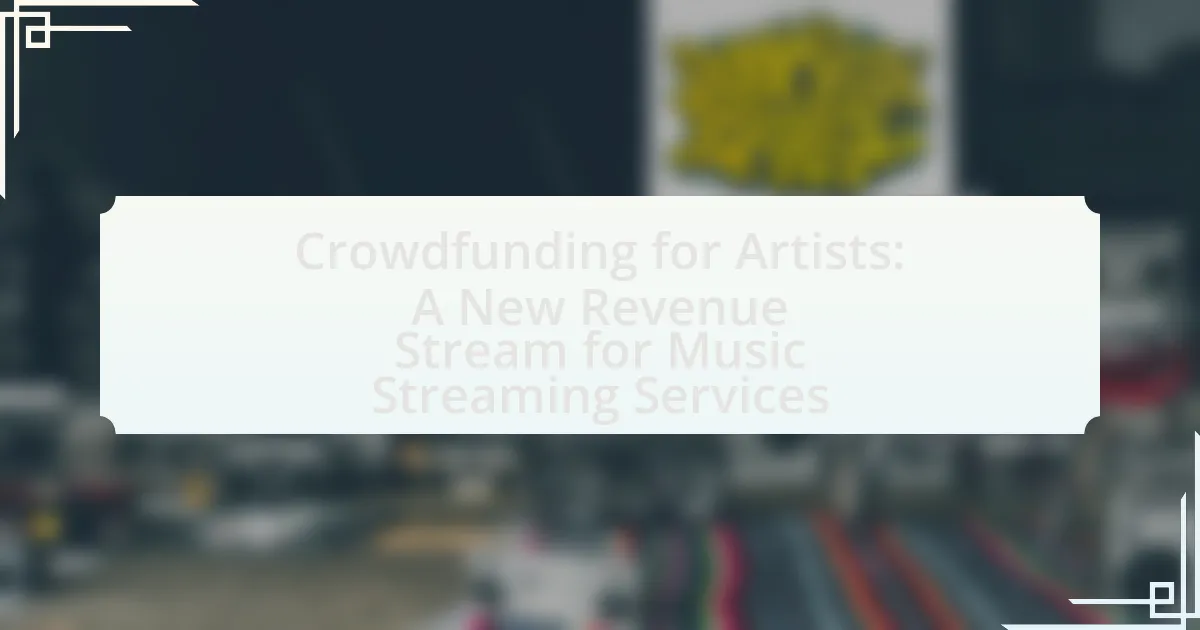Crowdfunding for artists, particularly in the context of music streaming services, is a financial model where musicians seek monetary support from fans to fund projects such as album production and tours. This approach allows artists to bypass traditional funding methods, engaging directly with their audience through platforms like Kickstarter, Patreon, and Indiegogo. The article explores how crowdfunding works, the various platforms available, effective models for musicians, and the benefits and challenges associated with this funding method. Additionally, it discusses the role of music streaming services in facilitating crowdfunding, strategies for successful campaigns, and the impact on artist-fan relationships.

What is Crowdfunding for Artists in the Context of Music Streaming Services?
Crowdfunding for artists in the context of music streaming services refers to the practice where musicians solicit financial contributions from fans and supporters to fund their projects, such as album production or tours, leveraging platforms that integrate with streaming services. This model allows artists to bypass traditional funding routes, enabling them to engage directly with their audience, who can support their work in exchange for exclusive content or experiences. For instance, platforms like Patreon and Kickstarter have become popular among musicians, with statistics showing that successful crowdfunding campaigns can raise thousands of dollars, thus providing a viable revenue stream that complements earnings from music streaming royalties.
How does crowdfunding work for artists?
Crowdfunding for artists involves raising funds from a large number of people, typically via online platforms, to support creative projects. Artists present their projects on crowdfunding websites, detailing their goals, funding needs, and rewards for backers. For example, platforms like Kickstarter and Indiegogo allow artists to set a funding target and a deadline; if the target is met, the funds are released to the artist. This method has gained popularity, with statistics showing that in 2020, over $17 billion was raised through crowdfunding in the U.S. alone, indicating a robust market for artists seeking financial support for their work.
What platforms are available for artists to crowdfund their projects?
Artists can use platforms such as Kickstarter, Indiegogo, Patreon, GoFundMe, and Seed&Spark to crowdfund their projects. Kickstarter and Indiegogo are popular for project-based funding, allowing artists to set funding goals and offer rewards. Patreon provides a subscription model where fans support artists on a recurring basis. GoFundMe is often used for personal projects and emergencies, while Seed&Spark focuses specifically on film and creative projects, offering additional resources for filmmakers. These platforms have facilitated millions in funding for creative endeavors, demonstrating their effectiveness in supporting artists.
What types of crowdfunding models are most effective for musicians?
Reward-based crowdfunding models are the most effective for musicians. These models allow artists to offer incentives, such as exclusive content or merchandise, in exchange for financial support from fans. Platforms like Kickstarter and Indiegogo have demonstrated success in this area, with Kickstarter reporting that music projects have raised over $200 million since its inception. Additionally, equity crowdfunding, where fans can invest in a musician’s future earnings, is gaining traction, as seen with platforms like Patreon, which allows artists to receive ongoing support from subscribers. These models not only provide financial backing but also foster a deeper connection between musicians and their audience, enhancing fan loyalty and engagement.
Why is crowdfunding becoming a popular revenue stream for artists?
Crowdfunding is becoming a popular revenue stream for artists because it allows them to directly engage with their audience and secure funding for their projects without relying on traditional financial institutions. This method empowers artists to maintain creative control and build a loyal fanbase, as they can offer exclusive rewards and experiences in exchange for financial support. According to a 2021 report by Statista, crowdfunding platforms raised over $12 billion globally, indicating a growing trend in alternative funding sources for creative endeavors.
What challenges do artists face in traditional funding methods?
Artists face significant challenges in traditional funding methods, primarily due to limited access to financial resources and the competitive nature of the arts market. Traditional funding avenues, such as grants and sponsorships, often have stringent eligibility criteria and lengthy application processes, which can deter many artists from applying. Additionally, reliance on these methods can lead to financial instability, as funding is not guaranteed and may be subject to economic fluctuations. According to a report by the National Endowment for the Arts, only about 40% of artists receive funding through traditional means, highlighting the scarcity of available resources. This lack of funding can hinder artists’ ability to create and promote their work effectively, ultimately impacting their career sustainability.
How does crowdfunding empower artists financially?
Crowdfunding empowers artists financially by providing them with direct access to funding from their supporters, bypassing traditional financial gatekeepers. This model allows artists to raise capital for projects such as albums, tours, or art installations by soliciting small contributions from a large number of people, often through platforms like Kickstarter or Indiegogo. For instance, a study by the University of Pennsylvania found that successful crowdfunding campaigns can raise an average of $7,000, demonstrating the potential for significant financial support. Additionally, crowdfunding fosters a sense of community and engagement, as backers often feel personally invested in the artist’s success, which can lead to increased loyalty and future support.

What role do music streaming services play in facilitating crowdfunding?
Music streaming services play a crucial role in facilitating crowdfunding by providing platforms where artists can directly engage with their fanbase and solicit financial support for projects. These services often integrate features that allow artists to promote crowdfunding campaigns, share exclusive content, and offer rewards to backers, thereby enhancing the visibility and appeal of their funding efforts. For instance, platforms like Patreon and Bandcamp enable artists to create subscription models or pre-order systems, which can be linked to their music streaming profiles, effectively turning listeners into financial supporters. This integration not only helps artists secure funding but also fosters a deeper connection between them and their audience, as fans feel more invested in the artists’ creative journeys.
How can music streaming platforms integrate crowdfunding features?
Music streaming platforms can integrate crowdfunding features by incorporating tools that allow artists to solicit financial support directly from their fans. This can be achieved through features such as project-based funding campaigns, where artists set specific financial goals for new albums or tours, and fans can contribute varying amounts in exchange for exclusive rewards like early access to music or merchandise.
Platforms like Kickstarter and Patreon have successfully demonstrated this model, showing that direct fan engagement can lead to significant funding for creative projects. For instance, in 2020, over $1 billion was pledged to music projects on Kickstarter, highlighting the demand for such crowdfunding options. By implementing similar systems, music streaming services can create a new revenue stream while fostering a closer connection between artists and their audiences.
What are the benefits of integrating crowdfunding into music streaming services?
Integrating crowdfunding into music streaming services provides artists with a direct revenue stream and enhances fan engagement. This model allows fans to financially support their favorite artists, enabling them to fund projects such as albums, tours, or merchandise. According to a 2021 study by the Music Industry Research Association, crowdfunding can increase an artist’s income by up to 30%, demonstrating its effectiveness as a supplementary revenue source. Additionally, crowdfunding fosters a sense of community among fans, as they feel more connected to the artists they support, leading to increased loyalty and long-term patronage.
How do artists leverage streaming platforms for crowdfunding success?
Artists leverage streaming platforms for crowdfunding success by utilizing features such as fan subscriptions, exclusive content, and direct engagement with their audience. These platforms allow artists to create tiered membership options where fans can contribute financially in exchange for perks like early access to music, behind-the-scenes content, or personalized experiences. For instance, platforms like Patreon and Bandcamp enable artists to set up crowdfunding campaigns directly linked to their music, facilitating a steady income stream. According to a 2021 report by the Music Industry Research Association, artists who actively engage with their fanbase on streaming platforms can increase their funding success by up to 30%, demonstrating the effectiveness of this approach in generating revenue.
What impact does crowdfunding have on artist-fan relationships?
Crowdfunding significantly enhances artist-fan relationships by fostering direct engagement and collaboration. This financial model allows fans to support artists directly, creating a sense of ownership and investment in the artist’s work. For instance, a study by the University of Southern California found that artists who engage in crowdfunding often report stronger emotional connections with their supporters, as fans feel more involved in the creative process. Additionally, platforms like Kickstarter and Patreon enable artists to communicate regularly with their backers, further solidifying these relationships through updates and exclusive content. This dynamic not only increases fan loyalty but also encourages a community around the artist, ultimately leading to sustained support and a more personalized experience for fans.
How does crowdfunding enhance fan engagement and loyalty?
Crowdfunding enhances fan engagement and loyalty by allowing fans to directly support artists and projects they care about, fostering a sense of community and ownership. This direct financial involvement creates a personal connection between fans and artists, as fans feel their contributions have a tangible impact on the artist’s success. Research indicates that campaigns with higher fan involvement often see increased loyalty, as fans who contribute are more likely to attend events, purchase merchandise, and promote the artist within their networks. For example, a study by Indiegogo found that campaigns with engaged backers raised 143% more than those without, demonstrating the correlation between crowdfunding participation and enhanced fan loyalty.
What are the potential downsides of crowdfunding for artists and fans?
The potential downsides of crowdfunding for artists and fans include financial risk, lack of guaranteed success, and potential strain on artist-fan relationships. Artists may face financial loss if their campaigns do not meet funding goals, as they often invest time and resources upfront without assurance of return. Additionally, crowdfunding does not guarantee that projects will be completed as promised, leading to disappointment among fans who contribute. This can create tension in the artist-fan relationship, especially if expectations are not met or if funds are mismanaged. According to a study by the University of Pennsylvania, approximately 30% of crowdfunding projects fail to deliver rewards, highlighting the inherent risks involved for both parties.

What are the best practices for artists using crowdfunding on music streaming services?
The best practices for artists using crowdfunding on music streaming services include setting clear funding goals, engaging with fans through regular updates, and offering attractive rewards. Clear funding goals help artists communicate their needs effectively, increasing the likelihood of reaching their targets. Engaging with fans fosters a sense of community and keeps supporters informed, which can enhance their commitment to the project. Offering attractive rewards, such as exclusive content or experiences, incentivizes contributions and can lead to higher funding amounts. According to a study by the University of Southern California, projects with well-defined goals and active fan engagement are 50% more likely to succeed in crowdfunding campaigns.
How can artists effectively promote their crowdfunding campaigns?
Artists can effectively promote their crowdfunding campaigns by leveraging social media platforms to engage their audience and share compelling content. Utilizing platforms like Instagram, Facebook, and Twitter allows artists to reach a wider audience, showcase their work, and provide updates on their campaign progress. According to a study by the University of Pennsylvania, campaigns that actively engage with their backers on social media raise 50% more funds than those that do not. Additionally, artists should create a strong narrative around their project, explaining its significance and how it impacts their community, which can resonate with potential backers.
What strategies can artists use to reach their funding goals?
Artists can reach their funding goals by utilizing crowdfunding platforms, which allow them to directly engage with their audience and secure financial support for their projects. Crowdfunding has proven effective, with platforms like Kickstarter and Indiegogo reporting that successful campaigns often exceed their funding targets by leveraging social media for promotion and building a strong community around their work. For instance, a study by the University of Pennsylvania found that campaigns that effectively communicate their vision and offer compelling rewards can raise significantly more funds, demonstrating the importance of clear messaging and audience engagement in achieving funding success.
How important is transparency in crowdfunding campaigns?
Transparency is crucial in crowdfunding campaigns as it builds trust between creators and backers. When campaigners provide clear information about project goals, funding allocation, and progress updates, they enhance credibility and encourage more contributions. Research indicates that campaigns with transparent communication are 50% more likely to reach their funding goals, as backers feel more secure in their investments. This trust is essential in the competitive landscape of crowdfunding, particularly for artists seeking support through platforms associated with music streaming services.
What common pitfalls should artists avoid in crowdfunding?
Artists should avoid several common pitfalls in crowdfunding, including setting unrealistic funding goals. When artists establish goals that are too high, they risk not reaching the target, which can lead to project failure and loss of credibility. Additionally, neglecting to engage with their audience can diminish support; consistent communication and updates are crucial for maintaining backer interest. Furthermore, failing to offer compelling rewards can result in lower contributions, as backers often seek tangible incentives for their support. Lastly, not planning for post-campaign fulfillment can lead to logistical challenges and dissatisfaction among backers, undermining future crowdfunding efforts.
How can artists manage expectations with their backers?
Artists can manage expectations with their backers by clearly communicating project timelines, deliverables, and potential challenges. This involves providing regular updates on progress and being transparent about any changes that may affect the project. For instance, a study by the University of Pennsylvania found that successful crowdfunding campaigns often include frequent communication, which helps maintain trust and satisfaction among backers. By setting realistic goals and timelines, artists can align their backers’ expectations with the actual capabilities and circumstances of the project, thereby reducing the likelihood of disappointment.
What are the legal considerations artists must keep in mind?
Artists must keep in mind copyright law, contract law, and intellectual property rights when engaging in crowdfunding. Copyright law protects the original works of artists, ensuring they retain ownership and control over their creations. Contract law is crucial as artists often enter agreements with crowdfunding platforms, investors, or collaborators, which must be legally sound to avoid disputes. Additionally, understanding intellectual property rights helps artists navigate the complexities of sharing their work online, ensuring they do not infringe on others’ rights while protecting their own. These legal considerations are essential for safeguarding an artist’s work and financial interests in the crowdfunding landscape.
What resources are available for artists interested in crowdfunding?
Artists interested in crowdfunding can utilize platforms such as Kickstarter, Indiegogo, and Patreon, which are specifically designed to help creators raise funds for their projects. These platforms provide tools for setting funding goals, creating project pages, and engaging with backers. Additionally, resources like the “Crowdfunding for Creatives” guide by the Creative Independent offer insights into best practices and strategies for successful campaigns. Research indicates that projects on Kickstarter that have a clear narrative and engaging visuals are more likely to reach their funding goals, highlighting the importance of effective presentation in crowdfunding efforts.
Where can artists find educational materials on crowdfunding strategies?
Artists can find educational materials on crowdfunding strategies through platforms like Kickstarter, Indiegogo, and Patreon, which offer guides and resources tailored for creators. Additionally, websites such as CreativeLive and Skillshare provide courses specifically focused on crowdfunding for artists. Research indicates that successful crowdfunding campaigns often utilize these resources to enhance their strategies, as evidenced by a study published in the Journal of Business Research, which highlights the importance of educational support in achieving funding goals.
What communities or networks support artists in crowdfunding efforts?
Communities and networks that support artists in crowdfunding efforts include platforms like Kickstarter, Indiegogo, and Patreon. These platforms provide artists with the tools to create campaigns, engage with backers, and receive funding for their projects. Additionally, social media groups and forums, such as those on Facebook and Reddit, offer spaces for artists to share experiences, seek advice, and promote their crowdfunding initiatives. Research indicates that artists who actively engage with these communities often see higher success rates in their crowdfunding campaigns, as they can leverage collective support and resources.

Leave a Reply